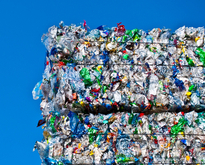 Despite the pandemic, the total traded amounts in € of glass, paper and cardboard secondary waste materials didn’t change significantly between 2019 and 2020, while for plastic it dropped by almost 18%. These waste materials are collected for recycling and are then used in manufacturing instead or alongside ‘virgin’ raw materials.
Despite the pandemic, the total traded amounts in € of glass, paper and cardboard secondary waste materials didn’t change significantly between 2019 and 2020, while for plastic it dropped by almost 18%. These waste materials are collected for recycling and are then used in manufacturing instead or alongside ‘virgin’ raw materials.
In 2020, the EU market presented a trade surplus in plastic (+1 million tonnes) and paper (+4.2 million tonnes) materials, indicating a drain of secondary raw materials.
Exports of secondary plastic materials from the EU Member States to non-EU countries amounted to 1.5 million tonnes in 2020, while exports of glass materials amounted to 0.34 million tonnes and exports of secondary paper materials amounted to 6.7 million tonnes. Compared to 2019, they represented a 4%, 12%, and 16% increase, respectively.
Source dataset: DS-645593
In 2020, imports of secondary glass materials from non-EU countries into the EU amounted to 0.6 million tonnes. Imports of secondary plastic materials to 0.6 million tonnes and paper to 2.6 million tonnes.
Compared with 2019, glass and paper secondary materials registered a 2% and 5% increase, while imports of secondary plastic materials declined by 17%.
Source dataset: DS-645593
As for prices of secondary waste materials, in 2020, a tonne of glass sold for €55, paper and cardboard for €104 and plastic for €245. Compared to 2019, prices dropped an average of 14%.
The observation of markets that trade these materials, which are originally used for consumer-related packaging, is less developed than the established markets for steel and aluminium scrap, but its findings are relevant to policy makers developing recycling strategies as part of the Circular Economy.
For more information:
- Statistics Explained article on recycling – secondary material price indicator
- Database on waste
- Dedicated section on waste
- All publications on waste
To contact us, please visit our User Support page.
For press queries, please contact our Media Support.



